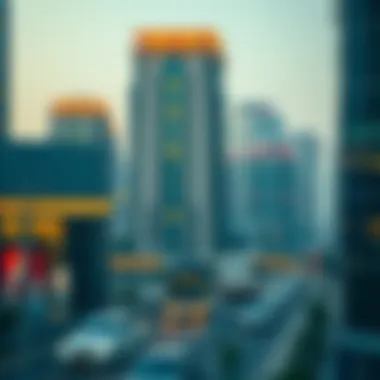Understanding Dubai's Land Area: Real Estate Insights


Intro
Dubai stands as a beacon of innovation and luxury in the Middle East, frequently drawing a multitude of investors and tourists alike. When looking at the land area of this vibrant city, it is much more than just numbers; it is a glimpse into opportunities waiting to be seized. Officially, Dubai covers around 4,114 square kilometers, a scenario that has transformed dramatically over the years due to ongoing developments and urban planning initiatives.
Understanding this significant expanse provides critical insights into real estate trends, investment potential, and overall urban development strategies. With land being a vital resource in a rapidly growing market, it’s pivotal for stakeholders like investors, developers, and buyers to grasp the implications tied to the land's geographical layout and its evolving use.
The article aims to delve into various aspects of this topic, offering an overview that captures current market trends, key neighborhood insights, as well as practical guidelines for buying and selling property. From luxury villas along the coast to skyscrapers in the downtown area, every corner of Dubai's land has a unique story leading toward potential investment gains.
In this exploration, we will highlight not just the numbers and boundaries, but also the dynamic forces shaping this global hub. Let’s navigate through the layers of Dubai's real estate landscape together.
Understanding Dubai's Land Area
Dubai's land area is more than just a measurement of physical space; it is a crucial aspect influencing the city’s burgeoning real estate market, growth dynamics, and urban development strategies. Understanding this area provides invaluable insight for investors, buyers, and real estate professionals alike. The land's geographic characteristics, current usage, and future potential are linked to economic trends, making it imperative to comprehend how they interact within the broader context of urban planning and investment opportunities.
This section examines the geographical aspects and total area measurements of Dubai, which help in comprehending its unique position as a global hub for business and tourism.
Geographical Overview
Location and Borders
Dubai's strategic location on the southeastern corner of the Arabian Peninsula acts as a bridge between the East and West, making it a prime spot for international trade and tourism. Bordered to the north by the Arabian Gulf, and sharing land borders with Abu Dhabi to the south and east as well as Sharjah to the northeast, it offers accessibility that few cities can rival. This beneficial positioning has not only supported rapid urban growth but also enhanced Dubai's appeal as a major global player in various sectors.
A unique feature of Dubai's location is its proximity to important shipping lanes, fostering economic ties and attracting multinational companies setting shop in the city. However, with all these advantages come challenges, particularly the environmental impact of urban expansion, which puts pressure on local ecosystems and water resources.
Natural Terrain and Features
Dubai's natural terrain is characterized by a combination of coastal areas, sandy deserts, and some irregular mountains that shape the development of the city. The coastal regions are essential for tourism, while the deserts provide land for residential and commercial development. The Dubai Creek, a naturally occurring inlet, plays a crucial role in the city’s history and urban design.
The sandy desert surrounding Dubai poses both challenges and opportunities for developers. While it limits traditional agricultural practices, it also offers vast areas for innovative architectural projects, such as desert resorts and extensive outdoor activities. This adaptability in leveraging terrain characteristics sets Dubai apart in attracting a global audience.
Climate Considerations
Dubai experiences a hot desert climate, with soaring temperatures peaking in the summer months. While this makes for a challenging environment in terms of outdoor living, the city has adapted effectively by creating many indoor spaces, including malls and leisure centers, that provide respite from the heat.
The Dubai government has invested significantly in climate-responsive infrastructure, such as air-conditioned bus stops, and urban tree planting initiatives designed to mitigate heat effects. This responsiveness to climate intricacies boosts the city’s attractiveness to expatriates and tourists, influencing property investments as more people seek comfort in their living environments.
Total Area Measurement
Size in Square Kilometers
Dubai covers an area of around 4,114 square kilometers, a significant expanse that has implications for its real estate development and urban planning. This sizable area not only allows for diverse land use but also facilitates the construction of large-scale projects, from residential complexes to luxury shopping malls.
The measurement of Dubai’s land area reflects the ambitious nature of its planning policies. However, it begs the question of sustainability as the city continues to grow. Balancing development with environmental responsibility is a challenge that land planners must face continuously.
Comparison with Other Major Cities
When compared to other major cities like New York or London, Dubai might not show the same density but does encompass a wider region with various zoning laws that allow for a mix of housing, commercial, and leisure properties. For instance, London's land area is approximately 1,572 square kilometers, yet its population density is significantly higher than that of Dubai.
This comparison highlights the potential for growth in Dubai's real estate market as it still has considerable space to develop, although urbanization trends must be addressed carefully to prevent overcrowding in certain areas.
Historical Changes in Land Area
Over the decades, Dubai's land area has significantly changed due to both natural and artificial influences. The discovery of oil propelled rapid urbanization, but so did the intentional land reclamation projects aimed at expanding valuable land for development. Notable projects like the Palm Jumeirah and the World Islands demonstrate the reality of Dubai's adaptive strategies in modifying its geography.
Throughout its history, these changes have allowed Dubai to tailor its suburban and urban landscapes, catering to tourism, business, and residential needs. However, such transformations have raised questions about sustainable practices and the long-term impact of altering natural landscapes.
Historical Context of Land Development
Understanding the historical context behind land development in Dubai provides valuable insights into the city’s growth trajectory. This context illustrates how past events and decisions shape current land use patterns and development strategies. Each phase in Dubai's evolution—from a modest fishing village to a global metropolis—carries lessons applicable for investors and stakeholders today.
Early Settlement and Growth
Pre-oil Era Development


Before the discovery of oil, Dubai's economy was primarily built on fishing, pearl diving, and trade. The pre-oil era saw the establishment of small settlements which focused on maritime activities due to the city's strategic coastal position. The key characteristic of this development was the reliance on natural resources available within the region. This era laid the groundwork for the community structure that we see today.
A fascinating feature of the pre-oil period was the Dhows, traditional wooden boats, which were utilized for trade. Such vessels played a significant role in shaping Dubai's maritime identity. The limitations of this era, however, included a sparse population and restricted technological advancement. This period is essential in illustrating how resource dependence led to modest growth while preparing the ground for future changes, particularly as external influences began to shape local economies.
The Impact of Oil Discovery
The discovery of oil in the 1960s marked a watershed moment for Dubai, thrusting it onto the global stage. This pivotal event transformed the economy rapidly, shifting focus from traditional trade to lucrative oil exports. The key element of this transformation was the influx of capital that enabled extensive infrastructure development. Important features included the establishment of roads, buildings, and utilities that were previously absent.
As oil revenues poured in, the government utilized the newfound wealth to invest in large-scale projects and initiatives. This ultimately attracted foreign investment and expatriates, changing the very fabric of Dubai's society. However, this rapid development also posed environmental challenges and risks associated with economic dependency on a single resource, creating questions about sustainability in the long term.
Evolution of the Urban Landscape
With the wealth generated from oil, the urban landscape of Dubai evolved dramatically, particularly from the late 20th century onwards. Diverse architectural styles emerged, from traditional Islamic designs to groundbreaking modern skyscrapers. The key characteristic of this evolution is the remarkable speed at which construction and urbanization took place, making Dubai a canvas for ambitious architectural feats.
Distinct features of this urban evolution include mega-developments like the Burj Khalifa and the Palm Jumeirah, which signify not only the aspirations of Dubai but also reflect global trends in tourism and luxury living. While the urban growth has attracted millions, it has also led to issues such as housing affordability and gentrification, which investors and developers must navigate as they plan for the future.
Key Development Milestones
Major Projects and Initiatives
Post-oil development has been characterized by grand projects and initiatives that serve various purposes—from boosting tourism to enhancing living standards. Notable projects include the creation of free zones that encourage foreign investment, as well as ambitious real estate projects like the Dubai Marina. The core aspect of these initiatives has been to diversify the economy and reduce dependence on oil.
Such developments offer advantages like increased job creation and infrastructural improvements. However, they also bring challenges, such as managing urban sprawl and ensuring sustainability. Understanding these projects offers insights into the regulatory framework that governs land use today.
Government Policies Shaping the Land Use
Government policies in Dubai have played a crucial role in shaping land use patterns and development strategies. Regulations aimed at controlling growth and promoting sustainable urban development are key to this process. An understanding of these policies reveals the government’s commitment to balancing economic growth with livability.
For instance, land allocation policies dictate where commercial and residential developments occur, while sustainability initiatives guide environmental considerations. These policies are beneficial as they foster long-term planning, though they also pose potential limitations for developers facing stringent regulations.
Influences of Global Events
Global events have significantly influenced Dubai's development trajectory. From economic downturns to health crises, such as the COVID-19 pandemic, the resilience of Dubai's economy is often tested. The key characteristic of this influence is the city's ability to adapt and reposition itself, often turning challenges into opportunities for growth and innovation.
Unique features of this global interplay include the implementation of strategies to enhance tourism and bolster the economy during downturns. While these adaptations can lead to positive outcomes, they can also present disadvantages, such as increased competition in the real estate market and pressure on resource management.
"Understanding the interplay between history and development in Dubai reveals crucial insights for future investments. The path taken is as significant as the destination."
Ultimately, diving into the historical context of land development in Dubai provides essential groundwork for stakeholders engaged in the real estate market. It deepens the understanding of past transformations, vital for making informed future investments.
Current Land Use Patterns
Understanding how land is utilized within Dubai is pivotal for anyone looking to invest or operate in the area. Current land use patterns provide a clear picture of what spaces are designated for residential, commercial, and industrial purposes. This segmentation not only helps buyers and investors identify lucrative opportunities but also reflects the socioeconomic tapestry of the city. From luxurious neighborhoods to bustling commercial hubs, each area has its distinct characteristics and implications for future developments.
Residential Areas
Types of Residential Properties
In the realm of real estate, knowing the various types of residential properties helps to gauge investment potential. Dubai boasts a wide array of options, ranging from opulent villas in Emirates Hills to more affordable apartment blocks in places like Dubai Marina. Each type comes with its own hallmark appeal. For instance, high-rise apartments often provide spectacular views of the Persian Gulf, making them a coveted choice for young professionals and expatriates. Villas, on the other hand, offer more space and privacy, suitable for families seeking a quieter environment.
Key characteristic: The diverse range of residential properties accommodates varying demographics, enhancing the market's appeal. This diversity allows investors to target specific segments based on lifestyle preferences or economic activity.
Unique feature: Some residential units come fully furnished, simplifying the buying process and making them appealing to non-resident buyers and expatriates.
However, while investing in luxury properties often yields higher returns, it also carries significant risks during economic downturns, emphasizing a need for astute market analysis.
Density and Distribution
Density and spatial distribution are crucial in understanding how population clusters contribute to urban life. Areas like Downtown Dubai are known for their high-density living. They thus become vibrant centers of activity. Conversely, suburban locales may feature lower density, which attracts families seeking space and a quieter pace of life.
Key characteristic: High-density districts often guarantee better access to amenities like schools and shopping centers, enhancing livability.
Unique feature: Properties in high-density areas typically appreciate faster due to increased demand.
Still, this comes with drawbacks. Overcongestion can lead to traffic snarls and stress on infrastructure, prompting city planners to rethink zoning laws and future developments.


Emerging Neighborhoods
Emerging neighborhoods, like Dubai South, illustrate how land use is evolving in the city. These areas are designed to cater to the growing population while emphasizing sustainability and smart urban planning.
Key characteristic: They often feature mixed-use developments, combining residential, commercial, and recreational space, which fosters a sense of community. This mix tends to attract younger demographics looking for a lifestyle that balances work and leisure.
Unique feature: Many of these areas include planned green spaces and community amenities. This shifting landscape not only supports growth but also aligns with global trends toward eco-friendly living.
Investing in emerging neighborhoods can present amazing opportunities, but interested investors should still consider possible early-stage risks, such as delays in infrastructure development or fluctuations in property values.
Commercial and Industrial Zones
Key Commercial Districts
Dubai is home to several key commercial districts, including the Dubai International Financial Centre (DIFC) and the Jebel Ali Free Zone (JAFZA). These zones play a significant role in the economic dynamics of the region and attract local and international investment.
Key characteristic: Such districts are often characterized by high-rise offices that symbolize the city’s aspirations. They serve as crucial hubs that facilitate business operations, contributing substantially to the emirate's GDP.
Unique feature: DIFC boasts a unique regulatory framework. This draws in multinational corporations, adding prestige and thereby, investment appeal.
Nevertheless, while these districts present lucrative opportunities, barriers like high operating costs could deter smaller businesses or startups from moving in.
Industrial Developments
On the industrial front, developments in Dubai emphasize logistics and manufacturing, particularly in areas such as JAFZA and Dubai Investments Park. These areas are strategically located, ensuring efficient transportation of goods and services.
Key characteristic: Many industrial parks also offer state-of-the-art facilities, catering to companies in diverse sectors. This development creates job opportunities and stimulates economic growth.
Unique feature: Flexible spaces allow businesses to adapt according to their needs, enhancing operational efficiency.
However, the industrial sector is facing challenges due to environmental regulations and sustainability initiatives, making adaptability a priority for current and future investors.
Impact on the Real Estate Market
The interplay between land use patterns and the real estate market in Dubai is striking. Commercial and industrial expansions directly influence property demand, affecting both residential and investment landscapes.
Key characteristic: Areas experiencing rapid development often see a surge in property values, in turn incentivizing more investment.
Unique feature: A strong rental market in key commercial locales can generate significant revenue for owners, attracting investors keen on maximizing returns.
While this growth is promising, market volatility can shift dynamics quickly, leading people to reassess long-term strategies.
An in-depth understanding of land use patterns in Dubai helps potential investors navigate the complex landscape effectively, enabling sound financial decisions.
Urban Planning and Future Developments
Urban planning and future developments play a pivotal role in shaping Dubai's dynamic landscape. As the city continues to expand, the significance of meticulous planning becomes increasingly apparent. Urban planners are tasked with not just accommodating the growing population but also enhancing the quality of life for residents and maintaining sustainability. Essentially, effective urban planning amalgamates various aspects, from infrastructure improvements to social amenities, ensuring that growth is not just about numbers, but about better living.
In Dubai, the focus is on integrating futuristic urban design concepts with the local culture. This comprehensive approach results in a livable city characterized by efficient transportation systems and green spaces. For investors and real estate professionals, understanding these developmental trajectories is essential, as they directly influence property values and investment potential.
Strategic Urban Planning Approaches
Sustainable Development Goals
Sustainable Development Goals (SDGs) are integral to Dubai's urban planning strategy. These goals promote practices that balance economic growth with environmental and social sustainability. The key characteristic of SDGs in this context is the emphasis on resilience — both in infrastructure and community adaptability. This approach is beneficial as it aligns with global standards while addressing local issues, thereby enhancing Dubai’s attractiveness to international investors.
One unique feature of incorporating SDGs is the city’s focus on renewable energy sources. For instance, projects like the Mohammed bin Rashid Al Maktoum Solar Park are a step toward reducing carbon footprints. However, a drawback might be the initial high investments required for setting such sustainability frameworks.
Smart City Initiatives
Smart City Initiatives have gained momentum in Dubai, characterized by the integration of technology to enhance urban living. These initiatives leverage data and digital technologies to improve public services and infrastructure. A primary advantage of this transition is the increased efficiency it brings to urban operations, such as traffic management and waste disposal.
One unique feature is the commitment to 100% smart meters for water and electricity by 2025. This not only supports energy conservation but also allows residents to monitor their consumption closely. However, there is a challenge in terms of ensuring equitable access to technology for all citizens, which is critical in preventing a digital divide.
Land Use Management Policies


Land Use Management Policies guide how land is allocated and utilized across Dubai. These policies are tailored to balance various needs — be it residential spaces, commercial zones, or green projects. The hallmark of these policies is their adaptability; they can evolve with changing societal demands, making them a popular choice for urban planners.
A notable unique feature of these policies is the encouragement of mixed-use developments, which allow for residential, commercial, and recreational areas to coexist. This not only enhances community cohesion but also promotes sustainable lifestyles. A potential downside could be the complexity in regulating mixed-use developments to satisfy all stakeholders efficiently.
Upcoming Projects Influencing Land Area
Major Real Estate Developments
Major real estate developments in Dubai signify not just urban growth but also a vibrant investment landscape. These large-scale projects typically attract substantial foreign investments and facilitate increased economic activity. A key characteristic is their focus on luxury and innovation, positioning Dubai as a premier global destination for high-net-worth individuals.
For instance, the Dubai Creek Tower is set to redefine the skyline and attract tourism and business alike. One unique feature here is its design, which takes inspiration from traditional Islamic architecture while utilizing cutting-edge technology. However, there is a risk inherent in such lofty ambitions — if the demand falters, these developments could lead to oversupply in the market.
Transportation Infrastructure Enhancements
Transportation Infrastructure Enhancements are crucial for supporting Dubai's rapid expansion. This involves the upgrade of existing systems and the introduction of new modes of transport. A prominent characteristic of these enhancements is their focus on connectivity — linking various parts of the city seamlessly.
An example is the introduction of the Dubai Metro's extension, which enhances mobility for the growing population. This feature offers several benefits including reduced traffic congestion and a boost to property values in proximity to stations. On the flip side, such projects often face delays and budget overruns, which can lead to frustration among stakeholders.
Impact on Regional Connectivity
The impact on regional connectivity ties closely with Dubai's strategic location as a commercial hub. Improved connectivity not only facilitates trade but also enhances tourism. A key characteristic of this focus is the development of multiple transport corridors that connect Dubai with neighboring emirates and countries.
The upcoming Etihad Rail project serves as a prime example, expected to link key cities across the UAE. This development is beneficial in boosting economic interactions while improving infrastructural robustness. However, the challenge remains in meticulously coordinating with environmental regulations to minimize disruptions in natural habitats.
Investment Considerations
When considering investments in Dubai's rapidly growing landscape, understanding the nuances of land area and its implications becomes crucial. Naturally, the size and layout of land, along with the ongoing development patterns, create a myriad of opportunities and risks for investors. This section delves into the market trends and risk factors associated with investing in Dubai's land area, equipping potential investors with valuable insights.
Market Trends Related to Land Area
Property Value Trends
The property value trends in Dubai present a fascinating narrative. Historically, steady appreciation is notable, reflecting the city's robust economic growth. With a landscape dominated by luxurious developments like Burj Khalifa and Palm Jumeirah, the prestige of properties drives demand. Investors typically appreciate properties in prime locations, commanding higher prices. However, it's worth noting that while certain areas see relentless price hikes, others struggle. Thus, understanding these patterns can guide savvy investors to make informed decisions about when and where to buy. The luxury segment particularly thrives, driven by expatriate investment.
Demand-Supply Dynamics
The demand-supply dynamics in Dubai provide an essential perspective on investment. The explosion of expatriate inhabitants has stimulated housing demands and commercial spaces, sometimes leading to scarcity in desirable neighborhoods. In contrast, some regions face oversupply due to rapid development outpacing demand. This duality means that thorough market research is essential. Investors who effectively analyze these dynamics can leverage them to capitalize on up-and-coming neighborhoods before they are widely recognized. Finding the right balance between demand and supply is the hallmark of astute investment.
Investment Opportunities by Location
Geographical diversity in Dubai means that investment opportunities vary dramatically by location. While areas like Downtown Dubai and Dubai Marina have proven to be gold coins, emerging areas such as Dubai South show promise with lower entry prices yet significant growth potential. Investors interested in diversified portfolios should aim for various neighborhoods to ensure risks are spread. Local amenities, infrastructure development, and accessibility all contribute to the desirability of these zones, impacting future returns. An informed strategy regarding location can set investors apart in a competitive market.
Examining Risk Factors
Environmental Risks
Investing in Dubai also comes with a set of environmental risks. Issues like extreme weather conditions and limited natural resources pose challenges that might affect property desirability over time. Moreover, rising sea levels present a legitimate concern for coastal properties. Investors must assess these factors cautiously. Integrating sustainability into future developments through green building initiatives is essential. Doing so not only mitigates risks but aligns with global standards and community expectations.
Market Volatility
The phenomenon of market volatility goes hand-in-hand with Dubai's investment landscape. Real estate prices can fluctuate due to global economic changes or local policy reforms. Nevertheless, the market is often seen as resilient, but it's not immune to downturns. Investors should remain vigilant due to the cyclical nature of property investment. Staying informed about global real estate trends can provide protective foresight in this dynamic atmosphere where timing can make all the difference.
Regulatory Challenges
Navigating the regulatory challenges surrounding real estate in Dubai can be complex. Legal frameworks can shift, impacting how properties are bought, sold, and developed. These conditions require investors to remain well-informed about local regulations, especially in terms of foreign ownership restrictions and property tax implications. Understanding the nuances of the local laws could mean the difference between a profitable investment and a costly mistake. Continuous engagement with legal professionals who specialize in Dubai's real estate market can provide significant advantage.
Finale
The exploration of Dubai's land area and its implications holds significant weight in understanding the dynamics of real estate and urban development in this vibrant metropolis. This article underscores the multifaceted aspects associated with land area measurement and how they are intertwined with investment potentials, urban planning strategies, and market trends. A dive into these elements reveals not only historical contexts but also the future trajectory of the city’s growth.
Summary of Key Insights
- Geographical Context: Dubai's strategic location between Europe, Asia, and Africa has made it a pivotal hub for trade and tourism. Its geographical advantages continue to shape land use and investment opportunities.
- Historical Development: The transformation from a modest fishing village into a global city is marked by significant milestones that reverberate through the current land distribution and real estate landscape. Understanding this history is crucial for anyone looking to gauge market movements.
- Land Use Patterns: The distribution of residential and commercial areas, along with industrial zones, highlights the existing trends that potential investors must navigate. The rise of emerging neighborhoods points to an evolving market ripe with opportunity.
- Future Urban Planning: Ongoing projects and strategic planning initiatives indicate a commitment to sustainable development. Investors should note how these efforts may influence property values and overall market stability.
- Investment Considerations: The interplay of demand-supply dynamics, risks involved, and unique investment opportunities position Dubai as a lucrative market. Identifying these factors can empower investors to make informed decisions, aiding their prospects in this gradually transforming landscape.
Future Prospects for Investors
Investors looking towards Dubai will find a city that is constantly adapting and growing. The future holds several promising angles worth considering:
- Emerging Markets: With numerous new projects in the pipeline, investors can tap into lesser-known neighborhoods before they become mainstream. Areas like Dubai South and Jumeirah Village Circle (JVC) show great potential.
- Innovative Developments: The city's push for sustainability and smart solutions in urban planning opens up avenues for green technologies and eco-friendly projects. Investors may find themselves at the forefront of a transformative era.
- Regulatory Environment: Keeping an eye on changes in investment laws and property regulations can clear the path for smoother transactions and fewer obstacles in the long run.
- Continued Global Interest: The influx of foreign investment continues to bolster the real estate market, making Dubai a magnet for investors looking for stable returns in a volatile world.
In summary, recognizing Dubai's land area implications not only informs risk assessments but allows investors to align their strategies with a city that is ever poised for further growth. Keeping abreast of trends and regulatory changes will equip stakeholders to harness the opportunities Dubai presents in the near and distant future.











